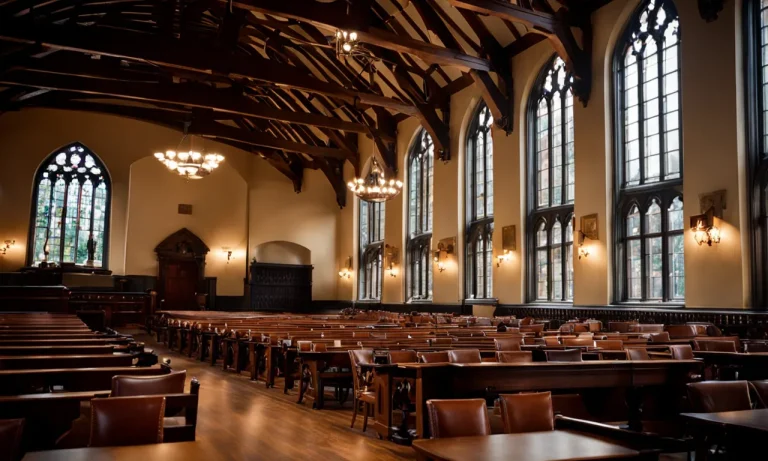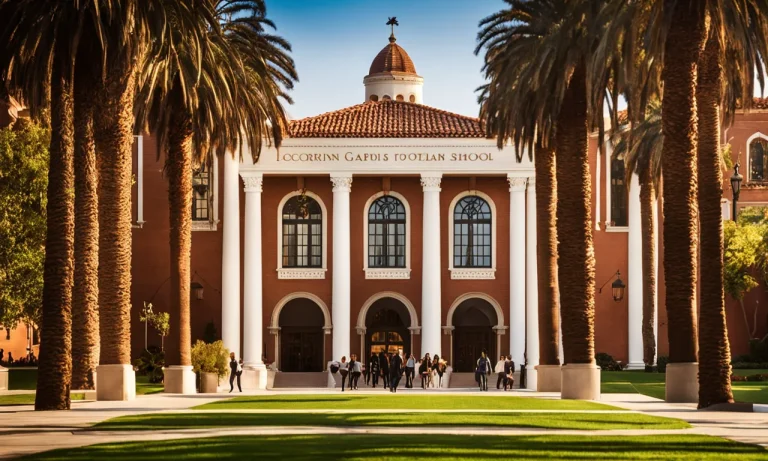The Pledge of Allegiance has been a staple of American public schools for decades, with students across the country participating in the patriotic recitation on a daily basis. However, California doesn’t make it obligatory to recite the Pledge of Allegiance in schools like many other states do, sparking controversy and confusion.
If you’re wondering why students in California no longer have to recite the pledge and what impacts this decision may have, read on for a comprehensive look at this developing story.
Here’s a quick answer before we dive into the details: California Education Code Section 52720 outlines the requirement that schools in California conduct “appropriate patriotic exercises,” which include the Pledge of Allegiance, but it also specifies that any student “shall be fully excused from” these exercises upon the written request of their parent or guardian. This provision aligns with the First Amendment rights of students to choose whether or not to participate.
Background on the Pledge of Allegiance
The Pledge of Allegiance is a patriotic oath that is recited by millions of Americans, particularly in schools and government institutions, as a way to express loyalty to the United States. It has a rich history and has undergone various changes since its creation.
When and why the pledge was created
The Pledge of Allegiance was first written in 1892 by Francis Bellamy, a Christian socialist minister, as a way to promote patriotism and national unity. It was originally intended to be recited by students during the 400th anniversary celebration of Christopher Columbus’ arrival in the Americas.
The original version of the pledge read: “I pledge allegiance to my Flag and the Republic for which it stands, one nation, indivisible, with liberty and justice for all.”
View this post on Instagram
Key elements of the pledge
The pledge has evolved over time, and its current version, adopted in 1954, includes the addition of the phrase “under God.” The key elements of the pledge include the following:
- The pledge begins with the phrase “I pledge allegiance to the Flag of the United States of America.”
- It emphasizes the unity and indivisibility of the nation.
- The pledge affirms the principles of liberty and justice for all.
- It ends with the phrase “one nation, under God, indivisible, with liberty and justice for all.”
Use of the pledge in schools over time
The recitation of the Pledge of Allegiance has been a longstanding tradition in American schools. It has been seen as a way to instill patriotism and a sense of civic responsibility in students. However, the use of the pledge in schools has not been without controversy.
Over the years, there have been debates and legal challenges regarding the mandatory recitation of the pledge in schools. In 1943, the Supreme Court ruled in the case of West Virginia State Board of Education v. Barnette that forcing students to recite the pledge violated their First Amendment rights.
Since then, students have had the right to choose whether or not to participate in the recitation of the pledge.
Recently, there have been discussions and controversies surrounding the use of the pledge in schools. For example, in California, there have been reports of schools banning the recitation of the pledge for various reasons, including concerns about the phrase “under God” and the potential exclusion of students who do not identify with a particular religious belief.
It is important for parents, educators, and policymakers to understand the historical context and significance of the Pledge of Allegiance, as well as the legal rights of students when it comes to its recitation in schools.
For more information on the history of the Pledge of Allegiance, you can visit the official website of the United States Flag.
California’s Proposed Ethnic Studies Model Curriculum
California’s proposed Ethnic Studies Model Curriculum is a framework that aims to provide students with a comprehensive understanding of the experiences and contributions of different ethnic groups in the United States.
The curriculum is designed to promote inclusivity, diversity, and social justice in education. It seeks to challenge traditional narratives and encourage critical thinking among students.
View this post on Instagram
Overview of the curriculum and its goals
The proposed curriculum covers a wide range of topics, including the history, culture, and contributions of various ethnic groups such as African Americans, Asian Americans, Latino/a Americans, and Native Americans. It aims to foster a sense of belonging and empower students from all backgrounds.
The goals of the curriculum include promoting cultural competency, fostering empathy and understanding, and equipping students with the knowledge and skills to participate in a diverse society. By examining the experiences of marginalized communities, the curriculum seeks to challenge stereotypes and encourage students to become advocates for social justice.
Ethnic Studies Model Curriculum doesn’t ban the pledge
The California Ethnic Studies Model Curriculum (ESM) does not explicitly mention the Pledge of Allegiance, but it does include a section on civic engagement. This section discusses the importance of civic participation and the rights and responsibilities of citizenship. It also provides examples of different ways to engage in civic life, such as voting, volunteering, and participating in protests.
Some educators have argued that reciting the Pledge of Allegiance is a form of civic engagement, so the ESM should mention it explicitly. Others have argued that reciting the pledge is not necessary for civic engagement, and that the ESM should focus on other forms of civic engagement that are more inclusive and representative of the diversity of California students.
Ultimately, whether or not to recite the Pledge of Allegiance is up to each individual student and school district. The ESM does not require or prohibit the recitation of the pledge, but it does encourage students to engage in civic life in ways that are meaningful to them.
The main reason some may opt out of reciting the Pledge of Allegiance is that they find it exclusionary and believe it perpetuates a narrow definition of American identity. To patriotic Americans, decisions like this are considered controversial.
Supporters of the liberty to opt out of reciting the Pledge of Allegiance claim that it does not adequately represent the experiences and perspectives of marginalized communities.
It is important to note that the proposal does not ban the teaching of American history or patriotism. Instead, it encourages a more inclusive approach that recognizes the contributions and struggles of all Americans, including those from diverse ethnic backgrounds.
View this post on Instagram
Potential Impacts of skipping the Pledge
Effects on school culture and patriotism
Many schools in California skip the Pledge of Allegiance, which has raised concerns about its potential impact on school culture and patriotism. For many, reciting the Pledge has been a longstanding tradition that promotes unity and a sense of national pride among students.
Removing the Pledge from schools may lead to a decline in these values and a shift in the overall school atmosphere.
Supporters of the practice to skip the Pledge of Allegiance argue that it is important to create an inclusive environment in schools, where students from diverse backgrounds feel accepted and valued. They believe that the Pledge, with its reference to God, may alienate non-religious or non-Christian students.
By skipping the Pledge, they hope to foster a more inclusive and tolerant atmosphere.
However, opponents argue that the Pledge is a symbol of national unity and should be upheld as a way to instill a sense of patriotism in students. They believe that reciting the Pledge helps students develop a connection to their country and understand the values it stands for.
Legal considerations and constitutionality
The practice of skipping the Pledge of Allegiance in California schools raises legal considerations and questions about its constitutionality. The Pledge has been a controversial issue for many years, with debates over whether its inclusion of the phrase “under God” violates the separation of church and state.
Proponents of the tendency to skip the Pledge of Allegiance argue that the inclusion of “under God” in the Pledge is a violation of the Establishment Clause of the First Amendment, which prohibits the government from promoting or endorsing a specific religion.
They argue that by reciting the Pledge, schools are essentially endorsing a particular religious belief.
Patriotic Americans maintain that the phrase “under God” is not meant to promote a specific religion, but rather to acknowledge the nation’s religious heritage. They argue that the Pledge is a voluntary expression of patriotism and should be protected under the First Amendment’s guarantee of free speech.
Broader debates over use of the pledge in schools
The status of Pledge of Allegiance in California schools has reignited broader debates over its use in schools nationwide. This controversy is not unique to California, as other states and school districts have also faced challenges regarding the recitation of the Pledge.
Some argue that the Pledge is an important tradition that should be upheld in schools as a way to teach students about their civic duties and responsibilities. They believe that reciting the Pledge instills a sense of loyalty and respect for the country.
On the other hand, critics argue that the Pledge can be seen as a form of forced patriotism and may infringe upon students’ rights to freedom of speech and expression. They believe that students should have the option to opt-out of reciting the Pledge if they choose to do so.
As the debate continues, it is important to consider the perspectives of all stakeholders involved and find a balance that respects both freedom of speech and the principles of inclusivity and tolerance.
What Happens Next
As California allows skipping of the Pledge of Allegiance in schools, many people are wondering what will happen next. Here are some key points to consider:
Process for finalizing and implementing curriculum
Many schools in California skip the Pledge of Allegiance, but this is not an immediate change. The California Department of Education will need to work on finalizing and implementing the new curriculum. This process involves consultations with educators, administrators, and other stakeholders to ensure a smooth transition.
It is important to note that even if a specific school or student skips reciting of the Pledge of Allegiance, it does not mean they will no longer learn about and teach patriotism or civic responsibility. The curriculum will likely focus on other ways to instill these values in students.
Alternatives to reciting pledge in schools
The schools may need to find alternatives to reciting the Pledge of Allegiance. Some possible alternatives may include moments of silence for reflection, discussions on the meaning of patriotism, or even the introduction of alternative pledges that are inclusive of all students.
It will be interesting to see how schools adapt to this change and what creative solutions they come up with to foster a sense of unity and national pride among students.
Conclusion
Decision of many schools in California to skip the Pledge of Allegiance has stirred passionate reactions on both sides of the issue. While the proposed ethnic studies curriculum aims to be more inclusive, critics argue it goes too far in pushing aide a decades-old patriotic tradition.
The impacts of this controversial move remain to be seen as the curriculum continues through implementation. No matter your stance on the pledge itself, this debate highlights important questions about American identity, values and what bringing diverse groups together should look like in public schools.






